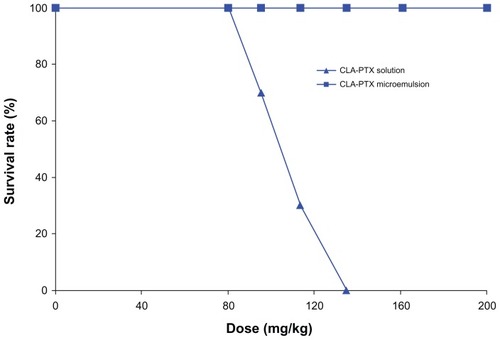Figures & data
Figure 1 Structure, molecular formula, and molecular weight of CLA-PTX.
Notes: Molecular formula of CLA-PTX C65H81NO15. Molecular weight of CLA-PTX 1116.
Abbreviation: CLA-PTX, linoleic acid conjugated with paclitaxel.

Figure 2 Typical droplet size and distribution of the CLA-PTX microemulsion (A) and transmission electron micrograph of CLA-PTX microemulsion (B).
Note: Bar 200 nm.
Abbreviation: CLA-PTX, linoleic acid conjugated with paclitaxel.
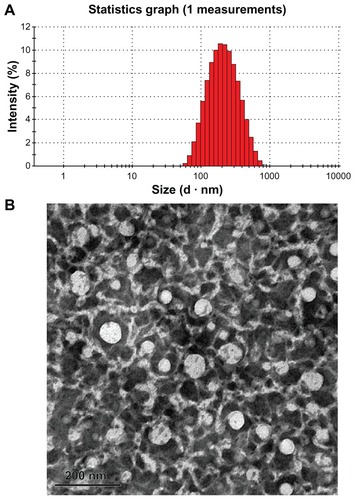
Table 1 Droplet size, polydispersity index, and zeta potential of CLA-PTX microemulsion (n = 3)
Table 2 Cytotoxicity of various CLA-PTX formulations for C6 cells (n = 3)
Figure 3 In vivo antitumor activity of CLA-PTX microemulsion in C6 tumor-bearing nude mice.
Notes: Balb/C nude mice were inoculated subcutaneously with C6 cells and treated with a 5% glucose infusion, Taxol® (15 mg/kg, intravenously, every 3 days for three doses), or CLA-PTX microemulsion 20 mg/kg (equimolar with 15 mg/kg of paclitaxel), intravenously every 3 days for three doses, respectively. The control group was given the 5% glucose infusion. Formulations were given intravenously via the tail vein. Throughout the study, the mice were weighed and tumors were measured with calipers every two days. **P < 0.01 versus 5% glucose infusion as control; ##P < 0.01 versus Taxol.
Abbreviation: CLA-PTX, linoleic acid conjugated with paclitaxel.
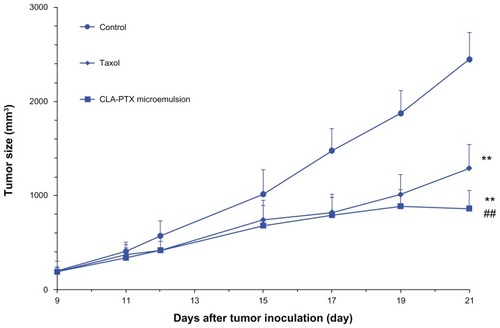
Figure 4 In vivo antitumor activity of CLA-PTX microemulsion in C6 brain tumor-bearing rats.
Notes: Tumor weight is shown at the time of sacrifice, 20 days post-inoculation. Formulations were administered intravenously via the tail vein at days 7, 10, and 13 after tumor inoculation. Animals were sacrificed on day 20 post-tumor inoculation (n = 10). Control group, 5% glucose infusion; Taxol® treatment group, at a dose of 5 mg/kg; CLA-PTX microemulsion treatment group, at a dose of 6.67 mg/kg (equimolar with 5 mg/kg of paclitaxel). **P < 0.01 versus 5% glucose infusion as control; ##P < 0.01 versus Taxol treatment group.
Abbreviation: CLA-PTX, linoleic acid conjugated with paclitaxel.
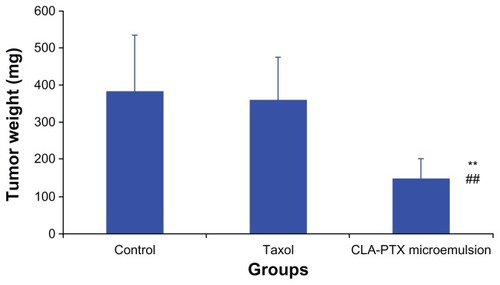
Table 3 Tumor weight inhibition (%) of CLA-PTX microemulsion against control and Taxol®
Figure 5 Plasma concentration-time profiles of CLA-PTX after intravenous administration of CLA-PTX solution or CLA-PTX microemulsion at 6.67 mg/kg CLA-PTX in Sprague-Dawley rats.
Notes: Mean ± standard deviation, n = 5.
Abbreviation: CLA-PTX, linoleic acid conjugated with paclitaxel.
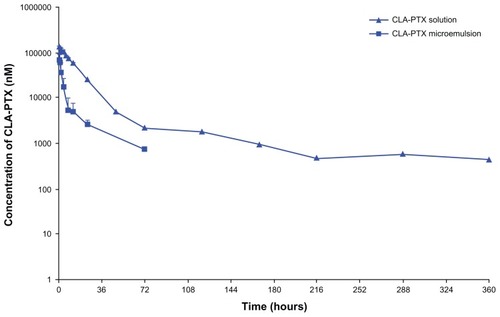
Table 4 Main pharmacokinetic parameters of CLA-PTX after intravenous administration of CLA-PTX solution or CLA-PTX microemulsion at 6.67 mg/kg of CLA-PTX in Sprague-Dawley rats (n = 5)
